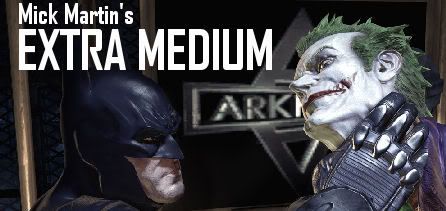
Comic books don't stay in comic books, and that fascinates me.
It's hardly a phenomenon. I know. It's part of the point. For better or worse, most comics - certainly the superhero ones - are produced in the hopes they will lead to films, cartoons, action figures, video games, backpacks, beach towels and bubble baths.
Regardless, there's something about the process of adapting a story from one medium to another that intrigues me. Maybe it's an intellectual curiosity that comes from nothing more complicated than the childlike surprise at seeing characters I had previously known only as frozen subjects on a page become more defined in a film or even a cartoon. Maybe it's because Hollywood's continuing trend of adaptations and remakes has so overtaken film that it seems like adapting a story from one medium to another has almost become an art form in and of itself.
Or maybe I'm just pissed off about organic webshooters. I don't know.
Extra Medium is a (weekly? bi-weekly?) column about this fascination of mine, of what happens when the stories in comics end up in films, television, books, and even video games. I may also explore the opposite: when stories from other media end up in comics. We'll see. This is something new to me and I don't have a lot of rules just yet.
For my first subject, I decided to look at the new PC/Console game Batman: Arkham Asylum. It's a fitting choice because, as I realized while I considered what to write about in my first column, the game is indirectly responsible for Extra Medium. It was a commercial for Batman: Arkham Asylum that renewed in me the desire to own a game console system - my last was a PlayStation 2 which I sold around 5 years ago. My lovely and generous girlfriend bought me an XBox 360 for my birthday, and since then I've been stunned by how utterly cinematic video games have become. I've been thinking a lot about whether or not certain video games could even be correctly called "games" anymore, rather than interactive movies. So when TWC formed and folks were asked what they wanted to write about, since I already had the blurring lines between media on the brain, Extra Medium was the result.
So, without any further delay other than a caveat that I have never even considered reviewing a video game before today so I hope I don't sound too dumb, I give you the first installment of Extra Medium.
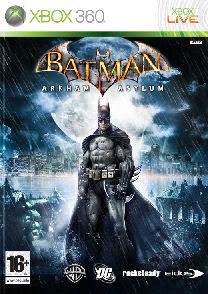 Batman: Arkham Asylum
Batman: Arkham AsylumPublisher: Eidos Interactive
Developer: Rocksteady Studios
Platforms Offered: PlayStation 3, XBox 360, PC
The Joker goes in and out of Arkham so often, they may as well rename it "Harley." This time, he plans to stay for a while. Backed by an army of muscle from Blackgate Prison and a handful of Batman's deadliest nemeses, the Joker plans to put Batman through the most hellish night of his life in Batman: Arkham Asylum.
In his BATMAN ALWAYS WINS column, Matt Springer wrote "There is no such thing as a "definitive Batman."" It's a strong statement, one I agree with, and it's part of what makes something like Batman: Arkham Asylum a challenge to create. Unlike Batman games of the past, Arkham Asylum isn't attached to any specific Batman film or TV show. That left the creators (among them, writer Paul Dini) with a long history of different interpretations of the dark knight from which to choose.
The result is a perfect marriage of the more recent and successful incarnations of Batman. In spite of the stellar success of Nolan's films, visually most of the ideas in Arkham Asylum seem to come from the comics. Characters like Joker, Scarecrow, and of course Batman himself look much more like the guys you'd find in the funnybooks. Of course, Nolan's influence is there in other ways. The game's music sounds mostly to have been culled from Batman Begins and The Dark Knight, though every great once in a while you're treated to a thunderous clanging of bells and singing that sounds like it could be a Danny Elfman contribution to one of Tim Burton's films. Also, during some truly disturbing Scarecrow sequences, things like the distortion of Scarecrow's voice and the red glow of his victims' eyes resemble how the character was depicted in Batman Begins. Batman: The Animated Series isn't forgotten. Arkham Asylum's creators recruited some of their talent from Batman: The Animated Series veterans including Kevin Conroy as Batman, Arleen Sorkin as Harley Quinn, and of course Mark Hamill as the Joker.
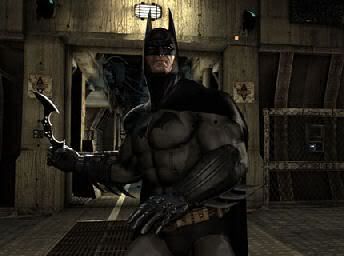
Along with Joker, players will find themselves locking horns with Harley Quinn, Zsasz, Scarecrow, Poison Ivy, Killer Croc and Bane though they're hardly the only super-baddies in Arkham. Just about any lover of superhero comics will love all the references - obscure or otherwise - to the broader mythology of Batman. Early in the game, the Riddler makes radio contact with Batman and challenges the dark knight to find dozens of objects Riddler's hidden on the island. They're not necessary to complete the game but you get rewards for completing challenges (I don't know them all, because honestly while I've finished the game I never managed to find everything). Some are simply "Riddler trophies" in hard-to-get-to spots. Some are patient interview tapes with inmates like Joker, Croc, Ivy, etc. Then there are certain items comicdom's favorite smart-ass didn't hide himself, but have to be identified with only his riddles for guidance, and many of these are objects belonging to, or newly emptied prison cells of, the absent members of Batman's rogue's gallery. While the villains don't appear in the game, players will find references to Penguin, Catwoman, Two-Face, the Ventriliquist, the Calendar Man, Mister Freeze, Mad Hatter and more. Mentioning my favorite of these fun additions would be a bit of a spoiler, so simply allow me to say the developers figured out a very inventive way to include Clayface in the game. And of course, all of these little references have potential to be more than simply references should Arkham Asylum enjoy a sequel, since Joker's actions have allowed for most of the aforementioned bad guys (including Riddler) to run free.
Also, while Batman: Arkham Asylum isn't the video game version of the Grant Morrison/Dave McKean GN of the same name (that would be one trippy damn video game), there's obviously a lot of inspiration from that story, as well as numerous direct references. The dark, tragic story of Amadeus Arkham is told in the game directly from the mouth of Arkham's ghost. Chapters of the tale can be accessed when the player finds stone tablets hidden in secret chambers, caves, and other various nooks and crannies throughout Arkham. Readers of the Morrison/McKean GN may notice the shapes of beetles littered throughout the architecture of Arkham's buildings. If you care to, you can even find Arkham's gravestone.
As far as its playability, controlling Batman is surprisingly easy. I'm still new to the most recent generation of video games, and I was worried there would be a complex button combination for every single move, but instead Arkham Asylum uses what the developers call a "freeflow" combat system. In other words, while there are maybe two moves that require specific button combos, for the most part there's one button to hit, one button to counter. The game decides exactly what Batman is going to do when you hit either button (e.g., whether he kicks a guy in the face or punches him in the stomach). It sounds almost too easy, but it's difficult to truly master. Eventually, you'll find yourself in the middle of crowds of literally a dozen or more thugs - some with automatic rifles, electrified batons, knives, and sometimes even boxes or cinder blocks they'll toss at your head - along with a Bane-ified thug or two, and it won't seem like child's play then. There's also a series of great stealth attacks. You can grab bad guys with grappling guns and pull them off catwalks. You can hang below them from a ledge, reach up, bang their heads on a railing and then throw them off. You can hang upside down from gargoyles (you had to know there'd be gargoyles), grab a thug, pull him up a wall and then hang him from the gargoyle. You can even wait until another thug walks under the first guy you strung up, cut the rope with a well-placed bat-a-rang, and take out the thug with the unconscious body of his buddy. As the game progresses, you get more and more gadgets (starting out with only bat-a-rangs), and your options just multiply from there.
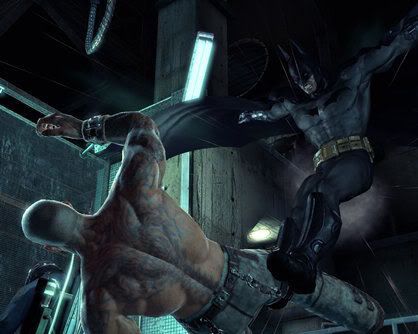
What becomes more and more clear as you progress in the game is that the developers were committed to bringing gamers an experience that truly felt like a Batman story, and that came as close as possible to making the players feel like Batman. One interesting thing to note is that, as far as I can tell, there is no way to kill anyone in Batman: Arkham Asylum. I've tried a number of ways and so far I haven't been able to do it. First, I tried pulling a thug off a security tower. As the thug fell, a rope appeared on his ankle and he dangled rather than splatted. Next, I tried using Batman's grappling gun to pull a bad guy into an electrified pool of water. No matter how close I pulled him to the pool, like an overprotective parent at the beach, the game wouldn't let him go in the water. Finally, I tried using the same grappling gun to yank a bad guy into a seemingly bottomless pit. I succeeded, but just as I thought I had changed the dark knight forever by making him take the life of another, the game produced a splashing sound. And mind you, Batman: Arkham Asylum is no kiddy story. There are some fairly gruesome and scary bits. So I doubt the developers went out of their way to stop Batman from being able to kill bad guys because of worries about keeping it kid-friendly. They did it because that's who Batman is.
It also helps that Batman: Arkham Asylum feels like a video game created to accommodate a story, and not the other way around. Maybe more experienced video game reviewers would disagree, but to me it felt like the game had very few honest-to-God Boss Fights. While you eventually defeat each bad guy, the story doesn't follow the usual model of getting through a level, ending with a bad guy you fight, and then on to the next level. There are some villains you never really fight in a face-to-face sense, and there are some you never even capture. You could even argue, in at least one instance, that defeating the villain means escaping him, not beating him up or capturing him. It makes it feel like a genuine Batman story. With the exception of, if you so choose, spending hours and hours finding all of Riddlers hidden extras, Batman: Arkham Asylum feels like something that could easily be a story in a comic book. Nothing about it would feel awkward or forced.
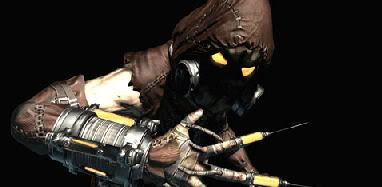
I have to make a special mention of one aspect of the game that is absolutely stunning - Scarecrow. Three times, Scarecrow hits you with his fear gas, and the sequences that follow are the best reasons to play this game. As Batman, you find yourself in a nightmarish abyss, with howling vortexes spinning above and below while you try to navigate floating islands of reality to hide from a Godzilla-sized Scarecrow with a Freddy-Kruegger glove sporting syringes instead of claws. I really don't want to say too much about these sequences because, of everything that happens in the game, these are the last things I would want to spoil. Suffice to say they're scary, they're brilliant, and in one part they lead to something I really never thought I'd see - a video game's retelling of the deaths of Bruce Wayne's parents that is genuinely touching and powerful.
I guess I'll follow the best thing I can say about this game with my biggest complaint, and it's fitting because they're related. The only thing I HATE about Batman: Arkham Asylum is that it uses an auto-save feature. In other words, the game automatically saves your progress in certain spots, and writes over everything you've done. Meaning you can't just, for example, save the moment before a Scarecrow sequence starts because you love it and just might want to play that part again and again and again.
Overall, anyone who has ever cared at all about Batman's exploits should be thrilled at the idea of playing Batman: Arkham Asylum. It's a testament to how the advances in video game technology have made it possible to not only make games that are more fun, but games that are more cinematic, aesthetically pleasing, and even emotionally powerful. It just depends on who's holding the reins.

No comments:
Post a Comment